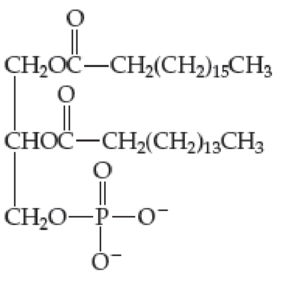
Fundamentals of General, Organic, and Biological Chemistry, Books a la Carte Plus Mastering Chemistry with Pearson eText -- Access Card Package (8th Edition)
8th Edition
ISBN: 9780134261256
Author: John McMurray, David S. Ballantine, Carl A. Hoeger, Virginia E. Peterson
Publisher: PEARSON
expand_more
expand_more
format_list_bulleted
Concept explainers
Textbook Question
Chapter 23.1, Problem 23.1P
Use Figure 23.1 to identify the family of lipids to which each of these molecules belongs.



Expert Solution & Answer
Want to see the full answer?
Check out a sample textbook solution
Students have asked these similar questions
Can koch's postulates of disease causation be applied to non-microorganism disease pathogens (such as molecules)?
Here is my literature Beta Carotene HPLC analysis graph.
Can you help me explain what each peak is at each retention time?
Thank You :D
I have a literature B-Carotene HPLC graph in which showcases a retention time of roughly 23.6 and 25.1.
Please help me compare my two different Anti-Oxidant Juice graphs. (Attached)
The juices provided are: V8 Carrot Ginger Blend and V8 Original Blend
Noticing the HPLC graphs I saw no peaks for the Original Blend for B-Carotene.
However the Carrot Ginger Blend showed similar peaks --> Why is this reason?
Please explain in terms of Retention time and Area (Under Curve).
Thank You!
Chapter 23 Solutions
Fundamentals of General, Organic, and Biological Chemistry, Books a la Carte Plus Mastering Chemistry with Pearson eText -- Access Card Package (8th Edition)
Ch. 23.1 - Use Figure 23.1 to identify the family of lipids...Ch. 23.2 - Prob. 23.2PCh. 23.2 - Prob. 23.3PCh. 23.2 - Prob. 23.4KCPCh. 23.3 - Prob. 23.1CIAPCh. 23.3 - Prob. 23.2CIAPCh. 23.3 - Prob. 23.3CIAPCh. 23.3 - Prob. 23.5PCh. 23.3 - Prob. 23.6PCh. 23.3 - Prob. 23.7KCP
Ch. 23.4 - Prob. 23.8PCh. 23.4 - Prob. 23.9PCh. 23.4 - Prob. 23.10PCh. 23.4 - Prob. 23.11PCh. 23.5 - Prob. 23.12PCh. 23.5 - Draw the structure of the sphingomyelin that...Ch. 23.5 - Draw the structure of the glycerophospholipid that...Ch. 23.5 - Prob. 23.16PCh. 23.7 - Prob. 23.17KCPCh. 23.7 - Prob. 23.4CIAPCh. 23.7 - Prob. 23.6CIAPCh. 23.7 - Prob. 23.7CIAPCh. 23.7 - Prob. 23.8CIAPCh. 23.7 - Prob. 23.18PCh. 23.7 - Prob. 23.19PCh. 23.7 - Prob. 23.20KCPCh. 23 - The fatty acid composition of three...Ch. 23 - Prob. 23.23UKCCh. 23 - According to the fluid-mosaic model (Figure 23.7),...Ch. 23 - Dipalmitoylphosphatidylcholine (DPPC) is a...Ch. 23 - Prob. 23.26APCh. 23 - Prob. 23.27APCh. 23 - Prob. 23.28APCh. 23 - Prob. 23.29APCh. 23 - Differentiate between saturated, monounsaturated,...Ch. 23 - Are the carboncarbon double bonds in naturally...Ch. 23 - Prob. 23.32APCh. 23 - Prob. 23.33APCh. 23 - Which of these fatty acids has the lower melting...Ch. 23 - Which of these fatty acids has the higher melting...Ch. 23 - Prob. 23.36APCh. 23 - Prob. 23.37APCh. 23 - Prob. 23.38APCh. 23 - Prob. 23.39APCh. 23 - What function does a wax serve in a plant or...Ch. 23 - Prob. 23.41APCh. 23 - Prob. 23.42APCh. 23 - What kind of lipid is spermacetia fat, a wax, or a...Ch. 23 - Prob. 23.44APCh. 23 - Prob. 23.45APCh. 23 - Prob. 23.46APCh. 23 - Prob. 23.47APCh. 23 - Prob. 23.48APCh. 23 - Prob. 23.50APCh. 23 - Prob. 23.52APCh. 23 - Prob. 23.53APCh. 23 - Describe the difference between a triacylglycerol...Ch. 23 - Why are glycerophospholipids, rather than...Ch. 23 - Prob. 23.56APCh. 23 - Prob. 23.57APCh. 23 - Why are glycerophospholipids more soluble in water...Ch. 23 - Prob. 23.59APCh. 23 - Prob. 23.60APCh. 23 - Prob. 23.61APCh. 23 - Draw the structure of a glycerophospholipid that...Ch. 23 - Prob. 23.63APCh. 23 - What is a major function of cholesterol in your...Ch. 23 - Prob. 23.65APCh. 23 - Prob. 23.66APCh. 23 - Prob. 23.67APCh. 23 - Explain how a micelle differs from a membrane...Ch. 23 - Prob. 23.69APCh. 23 - Prob. 23.70APCh. 23 - Prob. 23.71APCh. 23 - Prob. 23.72APCh. 23 - Prob. 23.73APCh. 23 - Prob. 23.74APCh. 23 - Prob. 23.75APCh. 23 - Draw the structure of a triacylglycerol made from...Ch. 23 - Prob. 23.79CPCh. 23 - Prob. 23.80CPCh. 23 - Explain why cholesterol is not saponifiable.Ch. 23 - Draw cholesterol acetate. Is this molecule...Ch. 23 - Prob. 23.83CPCh. 23 - Prob. 23.84CPCh. 23 - Prob. 23.85CPCh. 23 - Prob. 23.86CPCh. 23 - Prob. 23.88GP
Additional Science Textbook Solutions
Find more solutions based on key concepts
Whether two metal foil leaves an electroscope get opposite charge when the electroscope is charged.
Physics of Everyday Phenomena
2. Which of the following is the best example of the use of a referent? _
a. A red bicycle
b. Big as a dump tru...
Physical Science
Give the IUPAC name for each compound.
Organic Chemistry
Describe the evolution of mammals, tracing their synapsid lineage from early amniote ancestors to true mammals....
Loose Leaf For Integrated Principles Of Zoology
The active ingredient in Tylenol and a host of other over-the-counter pain relievers is acetaminophen (C8H9NO2)...
Chemistry: Atoms First
Why do scientists think that all forms of life on earth have a common origin?
Genetics: From Genes to Genomes
Knowledge Booster
Learn more about
Need a deep-dive on the concept behind this application? Look no further. Learn more about this topic, biochemistry and related others by exploring similar questions and additional content below.Similar questions
- Calculate pH of a solution prepared by dissolving 1.60g of sodium acetate, in 88.5 mL of 0.10 M acetic acid. Assume the volume change upon dissolving the sodium acetate is negligible. Ka is 1.75 x 10^-5arrow_forwardShow a mechanism that leads to the opening of the ring below under acid-catalyzed conditions. Give the correct Fischer projection for this sugar.arrow_forwardWhat is the stereochemical relationship between B & C?arrow_forward
- Don't use ai or any chat gpt will dislike okk just use accurate information okkk okkk just solve full accurate. don't use guidelines okk just did it accurate 100% sure experts solve it correct complete solutions okkk follow all instructions requirements okkkarrow_forwardhow would you make this plot in excel?arrow_forwardwhat is the productarrow_forward
- Balance the following equation and list of coefficients in order from left to right. SF4+H2O+—-> H2SO3+HFarrow_forwardProblem 15 of 15 Submit Using the following reaction data points, construct Lineweaver-Burk plots for an enzyme with and without an inhibitor by dragging the points to their relevant coordinates on the graph and drawing a line of best fit. Using the information from this plot, determine the type of inhibitor present. 1 mM-1 1 s mM -1 [S]' V' with 10 μg per 20 54 10 36 20 5 27 2.5 23 1.25 20 Answer: |||arrow_forward12:33 CO Problem 4 of 15 4G 54% Done On the following Lineweaver-Burk -1 plot, identify the by dragging the Km point to the appropriate value. 1/V 40 35- 30- 25 20 15 10- T Км -15 10 -5 0 5 ||| 10 15 №20 25 25 30 1/[S] Г powered by desmosarrow_forward
arrow_back_ios
SEE MORE QUESTIONS
arrow_forward_ios
Recommended textbooks for you
 Concepts of BiologyBiologyISBN:9781938168116Author:Samantha Fowler, Rebecca Roush, James WisePublisher:OpenStax College
Concepts of BiologyBiologyISBN:9781938168116Author:Samantha Fowler, Rebecca Roush, James WisePublisher:OpenStax College Biology Today and Tomorrow without Physiology (Mi...BiologyISBN:9781305117396Author:Cecie Starr, Christine Evers, Lisa StarrPublisher:Cengage Learning
Biology Today and Tomorrow without Physiology (Mi...BiologyISBN:9781305117396Author:Cecie Starr, Christine Evers, Lisa StarrPublisher:Cengage Learning Human Biology (MindTap Course List)BiologyISBN:9781305112100Author:Cecie Starr, Beverly McMillanPublisher:Cengage Learning
Human Biology (MindTap Course List)BiologyISBN:9781305112100Author:Cecie Starr, Beverly McMillanPublisher:Cengage Learning Biology: The Dynamic Science (MindTap Course List)BiologyISBN:9781305389892Author:Peter J. Russell, Paul E. Hertz, Beverly McMillanPublisher:Cengage Learning
Biology: The Dynamic Science (MindTap Course List)BiologyISBN:9781305389892Author:Peter J. Russell, Paul E. Hertz, Beverly McMillanPublisher:Cengage Learning Biology (MindTap Course List)BiologyISBN:9781337392938Author:Eldra Solomon, Charles Martin, Diana W. Martin, Linda R. BergPublisher:Cengage Learning
Biology (MindTap Course List)BiologyISBN:9781337392938Author:Eldra Solomon, Charles Martin, Diana W. Martin, Linda R. BergPublisher:Cengage Learning

Concepts of Biology
Biology
ISBN:9781938168116
Author:Samantha Fowler, Rebecca Roush, James Wise
Publisher:OpenStax College


Biology Today and Tomorrow without Physiology (Mi...
Biology
ISBN:9781305117396
Author:Cecie Starr, Christine Evers, Lisa Starr
Publisher:Cengage Learning

Human Biology (MindTap Course List)
Biology
ISBN:9781305112100
Author:Cecie Starr, Beverly McMillan
Publisher:Cengage Learning

Biology: The Dynamic Science (MindTap Course List)
Biology
ISBN:9781305389892
Author:Peter J. Russell, Paul E. Hertz, Beverly McMillan
Publisher:Cengage Learning

Biology (MindTap Course List)
Biology
ISBN:9781337392938
Author:Eldra Solomon, Charles Martin, Diana W. Martin, Linda R. Berg
Publisher:Cengage Learning
Macromolecules | Classes and Functions; Author: 2 Minute Classroom;https://www.youtube.com/watch?v=V5hhrDFo8Vk;License: Standard youtube license